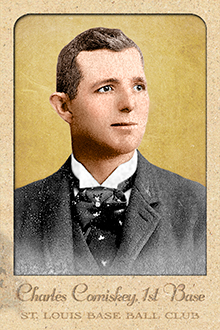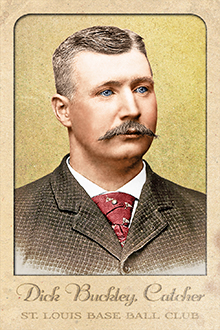
- Series: Pioneer Portraits II: 1875-1899
- City: New York
- Team: Metropolitans
- League: American Association
Joseph P. Crotty (1860-1926) was a catcher in two leagues: the American and Union Associations. He was in these organizations with 4 clubs from 1882 to 1886. Before, during and after these years in the “major leagues,” Crotty floated among numerous minor league franchises including the Sioux City Corn Huskers in whose uniform he appeared in the Old Judge series for 1889. A journeyman receiver, Crotty had a typically anemic batting average (.170 in MLB) but fared 100 points higher when in the lower echelons. His career did allow him to see the country: as far east as Syracuse, south to Jackson and west to Helena. Joe’s initial year, 1882, was also a year of firsts for his two clubs. He began in Louisville with the new Eclipse squad and then was picked up by Chris von der Ahe’s St. Louis Brown Stockings. This enabled him to be present at the creation of the Cardinals as the controversial owner brought the team into the American Association.
- Joe’s other ML clubs were the Cincinnati Outlaw Reds and the NY Metropolitans
- The Reds played in the UA’s only season, 1884, affording Crotty another chance to make a kind of history

- Series: Pioneer Portraits II: 1875-1899
- City: St. Louis
- Team: Browns (AA)
- League: American Association
- Hall: National Baseball Hall of Fame
Charles Albert Comiskey (1859-1931) rose from decent first-baseman to become one of the foremost managers and owners of baseball’s early decades. “The Old Roman’s” leadership skills emerged with his first team, the newly-minted St. Louis Browns whom he piloted to four pennants. He would go on to compile an outstanding 840-541 record. His .608 winning percentage is third-highest behind Joe McCarthy and Jim Mutrie. “Commy” parlayed his ownership of the Western Association’s Dubuque Rabbits into a franchise in the American League which he helped found in 1901. He built the White Sox stadium in 1910 which would bear his name for the next 81 years and presided for the next decade over one of the most talented and troubled teams in history. While many dismiss the charge that it was Comiskey’s penurious ways that “drove” his 1919 squad to infamy, there is no doubt he was a cheapskate of the first order. He underpaid, over-promised and reneged with abandon, epitomizing the arrogance of the reserve-clause era.
- Charles is credited with revolutionizing play at first-base, innovating play off the bag
- Owned the Chicago White Sox from 1901-1931, winning two World Series
- Elected to Hall of Fame: 1939

- Series: Pioneer Portraits II: 1875-1899
- City: St. Louis
- Team: Browns (AA)
- League: American Association
Richard D. Buckley (1858-1929) was a catcher with four teams over an eight-year career in the majors. He started with the Indianapolis Hoosiers in 1888 where he was behind the plate in 51 of his 71 games. Dick hit a robust .273 his rookie season. He played two full campaigns in Indiana, two with the Giants, two with St Louis and finished with two more with the Phillies, closing his MLB tenure in 1895 with a fine overall batting average of .245. Buckley wasn’t through with pro ball however, continuing in the minors with Midwest clubs until retiring at age 42 with the Omaha Omahogs of the Western League.
- Buckley was born to the game: in Troy, NY just at the beginnings of organized ball. In 1860 the Victories of Troy were one of 62 teams in the new NABBP, reconstituted in ‘66 as the Unions of Lansingburgh (a neighborhood in north Troy) where young Dick would have seen baseball’s finest come through town

- Series: Pioneer Portraits II: 1875-1899
- City: Philadelphia
- Team: Athletics (AA)
- League: American Association
Louis W. Bierbauer (1865-1926) was the treasure, buried then in the snows of Lake Erie, who gave his beloved Pittsburgh team its new name. Ned Hanlon was the privateer who braved the icy waters of Presque Isle in winter to sign the second-baseman away from the Athletics. This “piratical” act became so celebrated it gave the Alleghenys their permanent identity. Louie had done very well by the Athletics’s for his first four years in MLB. His year in the Players’ League with Ward’s Wonders was equally effective, causing the canny Hanlon to seize on Philadelphia’s lapse (they had not “reserved” Bierbauer). Lou rewarded his new club with six fine years at second base. Over his 13-year career, Lou would hit .267 with a .656 OPS. His performance stumbled a bit after joining the Pirates, but Bierbauer remained a strong hitter and defender through the 1896 season.
- Per Sporting Life in ’89: “Bierbauer is undoubtedly the king-pin second-baseman of the [American] Association”
- Ended his major league tenure in 1898 but continued in the minors. Lou managed the Canadian League’s St. Thomas Saints in 1915, his final year in pro ball



